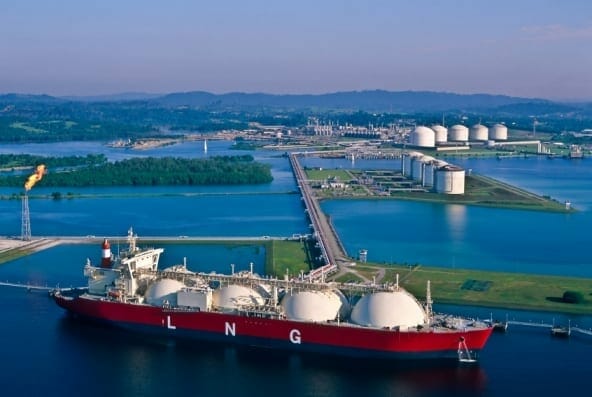Strait of Hormuz – LNG Tankers
There are currently 235 liquefied natural gas (LNG) tankers in operation worldwide.[i] New LNG tankers have an average capacity of three billion cubic feet, costing approximately $260 million each.[ii] LNG tankers differ from traditional oil tankers in that their cargo, liquefied natural gas, must be cooled to extremely low temperatures (-260°F) and has slightly different characteristics than oil (including a higher propensity to burn).[iii] LNG tankers typically use multiple, separate holds or compartments – each carrying up to 888,867 cubic feet of LNG. Storage compartments in traditional oil tankers typically hold only one-tenth as much.[iv]
LNG tankers present a unique set of safety and security concerns. LNG is more flammable than oil[v] causing great concern for the safety of these tankers when near large populations and infrastructure (i.e., at ports in urban areas). As a result, security agencies sometimes prompt special navigational restrictions and escort requirements in many of these sensitive ports.[vi] Despite these concerns, as of early 2008, “no significant loss of LNG tank cargo has ever occurred.”[vii] In fact, a direct hit by an Exocet missile to a LNG tanker during the Tanker War failed to cause an explosion (although this may have been due to a malfunction of the Exocet rather than the resilience of the LNG tanker itself).[xiii]

Safety and Security
A “worst-case scenario” of a damaged LNG tanker would involve a large initial explosion, most likely causing a fire, resulting in a thermal radiation zone of approximately .73 square miles. If the LNG tanker is close enough to land, then the inferno could spread from the water to land. Once LNG in a tanker ignites, it would essentially be impossible to extinguish the fire until it burned itself out of fuel ” after a major conflagration.[ix]
[i] Maritime Business Strategies, LLP, The World Fleet of LNG Tankers (as of 2007). Online. Available: http://www.coltoncompany.com/shipbldg/worldsbldg/gas/lngactivefleet.htm. Accessed: September 11, 2007.
[ii] Energy Information Administration, U.S. Natural Gas Markets: Mid-Term Prospects for Natural Gas Supply (December 14, 2001). Online. Available: http://www.eia.doe.gov/oiaf/servicerpt/natgas/chapter3.html. Accessed: September 11, 2007.
[iii] R.M. Pitblado, J Balk, G.J. Hughes, C. Ferro, and S.J. Shaw, Center for Chemical Process Safety Conference, Consequences of LNG Marine Incidents. Orlando, FL, June 29-July 1 2004. Online. Available: http://www.energy.ca.gov/lng/documents/CCPS_PAPER_PITBLADO.PDF. Accessed: September 11, 2007.
[iv] James A. Fay, “Spills and Fires from LNG and Oil Tankers in Boston Harbor,” Greenfutures.org (August 26, 2003). Online. Available: http://www.greenfutures.org/projects/LNG/Fay.html. Accessed: October 15, 2007.
[v] Paul W. Parfomak, Congressional Research Service – Report for Congress, Liquefied Natural Gas (LNG) Infrastructure Security: Background and Issues for Congress (September 9, 2003). Online. Available: http://www.energy.ca.gov/lng/documents/CRS_RPT_LNG_INFRA_SECURITY.PDF. Accessed: December 4, 2007.
[vi] Maritime Transport Committee, Organization for Economic Co-operation and Development (OECD), Security in Maritime Transport: Risk Factors and Economic Impact (July 2003). Online. Available: http://www.oecd.org/dataoecd/19/61/18521672.pdf. Accessed: September 11, 2007.
[vii] R.M. Pitblado, J Balk, G.J. Hughes, C. Ferro, and S.J. Shaw, “Consequences of LNG Marine Incidents,” (paper presented to the Center for Chemical Process Safety Conference, Orlando, FL, June 29-July 1 2004), p.6. Online. Available: http://www.energy.ca.gov/lng/documents/CCPS_PAPER_PITBLADO.PDF. Accessed: September 11, 2007.
[viii] Maritime Transport Committee, Organization for Economic Co-operation and Development (OECD), Security in Maritime Transport: Risk Factors and Economic Impact (July 2003). Online. Available: http://www.oecd.org/dataoecd/19/61/18521672.pdf. Accessed: September 11, 2007.
[ix] James A. Fay, Spills and Fires from LNG and Oil Tankers in Boston Harbor, (August 26, 2003). Online. Available: http://www.greenfutures.org/projects/LNG/Fay.html. Accessed: December 4, 2007.